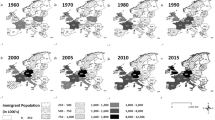Abstract
Suburban Chinatowns are intriguing subjects for study and comparison. These ethnic suburbs, or ethnoburbs, have emerged to coexist or compete with the older downtown Chinatowns traditionally found in American central cities. Their growth since the 1960s challenges many traditional assumptions regarding the spatial and cultural assimilation of immigrants in U.S. society, namely that ethnicity would decline with the geographic and socioeconomic mobility of immigrants from the inner city into the suburbs. We examined recent growth trends in the Chinese ethnoburb of the San Gabriel Valley region of Greater Los Angeles, through analysis and mapping of U.S. Census data, and discovered ethnic persistence rather than spatial and cultural assimilation. We also discovered the ethnoburb is differentiated between a lower-class core and two middle-to-upper class fringe districts. Though there is some linguistic assimilation on the northwest fringe, the majority of the ethnoburban population continues to speak Chinese. Linguistic isolation is not a barrier to achieving a higher socioeconomic class position in the Chinese ethnoburb of Los Angeles.
Similar content being viewed by others
References
J.P. Allen E. Turner (2002) Changing Faces, Changing Places: Mapping Southern Californians The Center for Geographic Studies, California State University Northridge
E. Burgess (1925) The growth of the city: an introduction to a research project R.E. Park (Eds) et al. The City University of Chicago Press Chicago 47–62
M. Castells P. Hall (Eds) (1994) Technopoles of the World: The Making of Twenty-First-Century Industrial Complexes Routledge London
T. Fong (1994) The First Suburban Chinatown: The Remaking of Monterey Park Temple University Press Philadelphia
J. Horton et al. (1987) The Politics of Diversity: Immigration, Resistance, and Change in Monterey Park Temple University Press Philadelphia
Klein K., 1997: At Home in America: Immigrant Home Buyers Are Driving the Southern California Market, The Los Angeles Times, April 20, pg. 1
J. Kotkin (2000) The New Geography Random House New York
J. Kotkin O. Erika (2002) The Changing Face of the San Fernando Valley Economic Alliance of the San Fernando Valley Los Angeles
P. Kwong (1987) The New Chinatown The Noonday Press New York
LAEDC (Los Angeles Economic Development Corporation). 2002. San Gabriel Valley: 2002–2003 Economic Overview and Forecast. Los Angeles Economic Development Corporation, Los Angeles.
Li W., 1998: Anatomy of a new ethnic settlement: the Chinese ethnoburbs in Los Angeles. Urban Studies 35(3).
W. Li (1999) ArticleTitleBuilding ethnoburbia: the emergence and manifestation of the Chinese ethnoburb in Los Angeles’ San Gabriel Valley Journal of Asian American Studies 2 1 1–28
J. Lin (1998a) Reconstructing Chinatown: Ethnic Enclave, Global Change University of Minnesota Press Minneapolis
Lin J., 1998b: Globalization and the revalorizing of ethnic places in immigration gateway cities. Urban Affairs Review
D. Massey (1985) ArticleTitleEthnic residential segregation: a theoretical and empirical review Sociology and Social Research 69 315–350
R.E. Park E.W. Burgess (1921) Introduction to the Science of Sociology University of Chicago Press Chicago
Phillips., 2003: West Coast: A Swath of Enterprise Where Feng Shui Hits, The New York Times, May 6, pg. G9
Pierson D., 2003: Mainlanders Make Mark Among Chinese Emigres, Los Angeles Times, August 13, pg. A1
L. Saito (1998) Race and Politics: Asians, Latinos and Whites in a Los Angeles Suburb University of Illinois Press Urbana
S. Sassen (1988) The Mobility of Labor and Capital Cambridge University Press Cambridge
A. Scott (1993) Technopolis: High-Technology Industry and Regional Development in Southern California University of California Press Berkeley
Timmerman K., 1997: China’s 22nd Province, The American Spectator 30, 10: 38–45.
Tseng Y.-f., 1995: Beyond Little Taipei: The Development of Taiwanese Immigrant Businesses in Los Angeles, International Migration Review 29 1
Urban Research Division, County of Los Angeles, 2001: San Gabriel Valley Job Creation and Growth, a report to the San Gabriel Valley Council of Governments. County
Wysocki B., 1996: Moving In: Influx of Immigrants Adds New Vitality to Housing Market Wall Street Journal, October 10, pg. A1
M. Zhou (1992) Chinatown: The Socioeconomic Potential of an Urban Enclave Temple University Press Philadelphia
Y. Zhou (1998) ArticleTitleBeyond ethnic enclaves: Location strategies of Chinese producer service firms in Los Angeles Economic Geography 74 IssueID3 228–52 Occurrence Handle10.2307/144375
Author information
Authors and Affiliations
Corresponding author
Additional information
An earlier version of this paper was presented at the American Sociological Association Annual Meeting, San Francisco, California, August 2004.
Rights and permissions
About this article
Cite this article
Lin, J., Robinson, P. Spatial Disparities in the Expansion of the Chinese Ethnoburb of Los Angeles. GeoJournal 64, 51–61 (2005). https://doi.org/10.1007/s10708-005-3923-4
Issue Date:
DOI: https://doi.org/10.1007/s10708-005-3923-4




